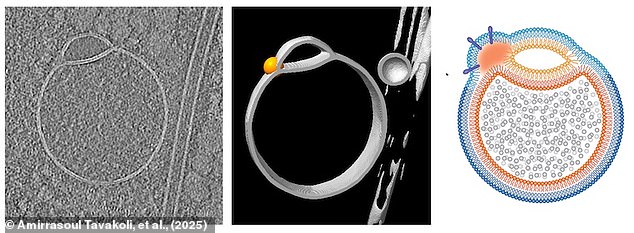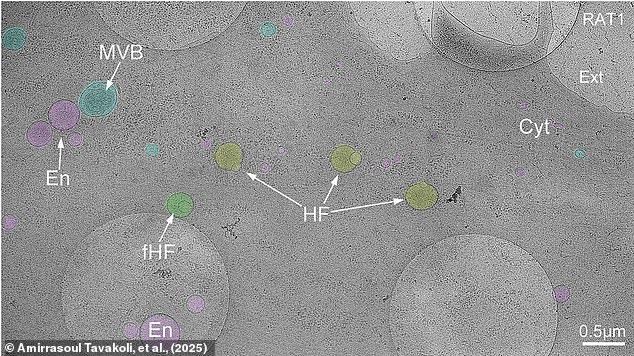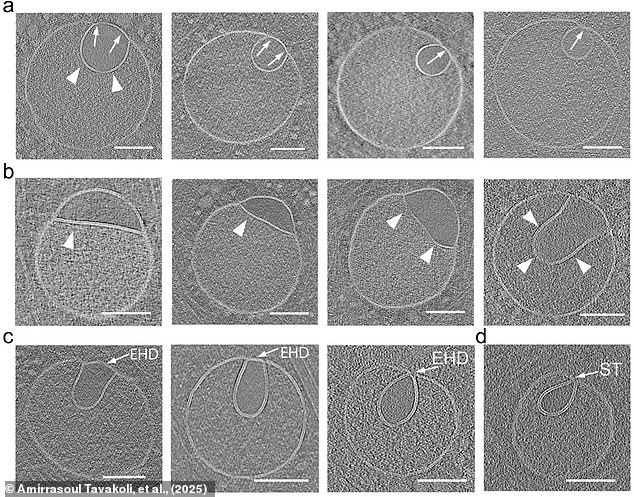Scientists have discovered a mysterious new structure lurking inside every human cell.
These tiny structures, dubbed hemifusomes, are just 200 to 400 nanometres in diameter.
To put that into perspective, that’s about 500 times thinner than a human hair.
Scientists believe the structures play a critical role in helping our cells recycle and discard waste materials.
Co-author Dr Seham Ebrahim, of the University of Virginia, says: ‘It’s exciting because finding something truly new inside cells is rare – and it gives us a whole new path to explore.
‘This is like discovering a new recycling centre inside the cell.
‘We think the hemifusome helps manage how cells package and process material, and when this goes wrong, it may contribute to diseases that affect many systems in the body.’
In the future, the finding could help scientists to develop treatments for conditions such as Hermansky-Pudlak syndrome – a rare genetic disorder that can cause albinism, vision problems, and lung disease.

Scientists have discovered a new type of structure hidden in human cells called the hemifusole (pictured), a tiny organelle which looks like two bubbles stuck together at the edge

At just 200 to 400 nanometres in diameter, hemifusoles (labelled HF) are about a fifth of the size of a mitochondria. Scientists needed to use a technique called cryo-electron tomography to spot them
Since hemifusomes are exceptionally small, the researchers needed extremely sensitive equipment to spot them.
The team used a method called cryo-electron tomography, in which samples are rapidly frozen to around -150°C (-240°F) before being sliced very thinly.
The scientists then took lots of photos with a powerful microscope which uses electrons instead of visible light.
This allowed them to look at extremely small structures just as they would appear in a living cell by freezing them in time, rather than damaging the samples by trying to preserve them.
Using this method, a team of researchers from the University of Virginia spotted structures which looked like two thin bubbles stuck together at the edges.
The researchers believe hemifusomes produce vesicles – tiny sacs that act as ‘mixing bowls’, as well as making structures made of lots of these vesicles.
Dr Ebrahim says: ‘You can think of vesicles like little delivery trucks inside the cell.
‘The hemifusome is like a loading dock where they connect and transfer cargo. It’s a step in the process we didn’t know existed.’

These structures create blister-like sacs called vesicles, which are used like mixing bowls inside the cell

By placing vesicles inside themselves, hemifusoles can store and combine different chemicals and waste products. Scientists think that some diseases might be caused when this process is disrupted
By building vesicles, and even putting vesicles inside each other, the hemifusomes allow our cells to package and sort proteins or recycle parts of the cell.
One thing that the researchers were surprised to find is that the layer which connects the hemifusome and the vesicles is much thinner than scientists previously thought possible.
This ‘hemifusion diaphragm’ sticks to the two structures together but doesn’t let their contents mix, like two water balloons that have melted together at the edges.
Previously, scientists thought these types of structures would be too unstable to do anything useful in our cells.
But in the hemifusome, the researchers spotted them playing a really important role in keeping our cells healthy.
That discovery could have big implications for how we understand and treat diseases which interfere with our cells’ recycling functions.
Dr Ebrahim says: ‘We’re just beginning to understand how this new organelle fits into the bigger picture of cell health and disease.
‘Now that we know hemifusomes exist, we can start asking how they behave in healthy cells and what happens when things go wrong. That could lead us to new strategies for treating complex genetic diseases.
